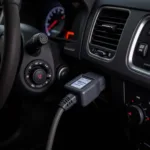Owning a BMW E46 is a thrilling experience, but like any car, it requires regular maintenance and occasional troubleshooting. While the E46 generation is known for its reliability, various electronic and mechanical components can still throw a curveball your way. This is where car diagnostics come into play. Understanding how to effectively diagnose your E46 can save you time, money, and unnecessary headaches.
Diving Deep into BMW E46 Car Diagnostics
Car diagnostics involve using specialized tools and software to communicate with your car’s onboard computer system, often referred to as the ECU (Engine Control Unit). This system monitors various sensors and components, storing crucial information about your vehicle’s health and performance. By accessing and interpreting these data points, you can pinpoint issues and take necessary actions.
For the E46 generation, BMW utilized the OBD-II (On-board Diagnostics, second generation) standard, making it compatible with a wide range of diagnostic tools.
Essential Diagnostic Tools for Your E46
Several tools can assist you in diagnosing your BMW E46:
-
Code Readers: These handheld devices are readily available and offer a basic level of functionality. They can retrieve and display diagnostic trouble codes (DTCs) stored in your car’s ECU, giving you a starting point for troubleshooting.
-
OBD-II Scanners: A step up from code readers, scanners provide more detailed information about the DTCs, including freeze frame data and the ability to clear codes.
-
BMW-Specific Scanners: For advanced diagnostics and coding, dedicated BMW scanners offer comprehensive functionalities tailored to the intricate systems found in these vehicles.
Beyond the physical tools, various software applications are available for computers and smartphones, providing real-time data logging, advanced diagnostics, and even coding capabilities.
Common Issues and Diagnostic Techniques
The BMW E46, despite its robust engineering, can exhibit certain common issues that lend themselves well to diagnostic techniques.
1. Engine Performance Problems:
Hesitation, rough idling, or a decrease in fuel efficiency can indicate problems with the air intake system, fuel delivery, or ignition system. Using a diagnostic tool, you can monitor parameters such as:
- MAF (Mass Air Flow) sensor readings: Fluctuations or readings outside the normal range can indicate a faulty sensor, impacting air-fuel mixture.
- Oxygen sensor data: Inconsistent readings might point towards a failing sensor, affecting emissions and fuel economy.
- Spark plug misfires: Monitoring misfire counts for each cylinder can help isolate ignition coil or spark plug issues.
2. Emission System Issues:
A glowing check engine light often signals an emission-related problem. Common culprits include:
- Faulty catalytic converter: Diagnostic tools can analyze oxygen sensor data before and after the catalytic converter to assess its efficiency.
- EVAP (Evaporative Emission Control) system leaks: Specialized smoke tests, often integrated with diagnostic equipment, can help pinpoint leaks in the EVAP system.
3. Electrical Gremlins:
The E46’s intricate electrical system can sometimes pose challenges. Diagnostic tools can be invaluable in identifying:
- Battery and charging system faults: Analyzing battery voltage, charging current, and alternator performance can reveal potential issues.
- Faulty sensors: From ABS sensors to camshaft position sensors, a diagnostic tool can retrieve sensor data and pinpoint anomalies.
Seeking Professional Help
While DIY diagnostics can be empowering, seeking assistance from a qualified mechanic specializing in BMWs is recommended for complex issues or when unsure about interpreting diagnostic data. Their expertise and specialized tools can save you time and potential misdiagnoses.
Conclusion
Mastering the art of BMW E46 car diagnostics can empower you to better understand your vehicle, address minor issues proactively, and communicate effectively with mechanics when necessary. By leveraging the power of diagnostic tools and information, you can keep your E46 running smoothly and enjoy the legendary performance for years to come.
FAQs
1. Can I use any OBD-II scanner on my BMW E46?
While generic OBD-II scanners can retrieve basic codes, investing in a BMW-specific scanner or software is recommended for comprehensive diagnostics and coding.
2. What does a flashing check engine light mean?
A flashing check engine light usually indicates a severe engine problem requiring immediate attention.
3. Can I clear fault codes myself?
Yes, most diagnostic tools allow you to clear fault codes. However, it’s crucial to address the underlying issue before clearing the codes, as they serve as valuable indicators for troubleshooting.
4. Where can I find reliable information about BMW E46 fault codes?
Reputable online forums dedicated to BMWs, manufacturer websites, and automotive repair manuals can offer insights into specific E46 fault codes.
5. My E46 is experiencing multiple issues. What should I do?
In such cases, prioritize addressing the most critical issues first, or consult with a qualified BMW mechanic for a comprehensive diagnosis.
Need expert assistance with your BMW E46 diagnosis? Contact us via WhatsApp: +1(641)206-8880, Email: [email protected]. Our dedicated team is available 24/7 to provide expert guidance and support.


